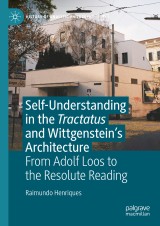Details

Self-understanding in the Tractatus and Wittgenstein's Architecture
From Adolf Loos to the Resolute ReadingHistory of Analytic Philosophy
|
CHF 142.00 |
|
| Verlag: | Palgrave Macmillan |
| Format: | |
| Veröffentl.: | 16.07.2024 |
| ISBN/EAN: | 9783031583841 |
| Sprache: | englisch |
| Anzahl Seiten: | 368 |
Dieses eBook enthält ein Wasserzeichen.
Beschreibungen
<p>Between 1926 and 1928, the philosopher Ludwig Wittgenstein designed a house for his sister in Vienna (the <em>Kundmanngasse</em>). This book aims to clarify the relation between that house and Wittgenstein’s early philosophy. The starting point of its main argument is a remark from <em>Diktat für Schlick</em> (c. 1932-33) in which Wittgenstein proposes an analogy between ornaments and nonsensical sentences. The attempt to extract from it an account of the relation between the Kundmanngasse and the <em>Tractatus Logico-Philosophicus</em> (1921) leads to the writings of Adolf Loos (whose influence Wittgenstein recognized). The discussion of Loos’s writings suggests that the analogy should be understood, not as one between actual ornaments and nonsensical sentences, but as one between Loos’s and Wittgenstein’s uses of these notions. So understood, it favors the (so-called) resolute reading of the <em>Tractatus</em> and reveals that both Wittgenstein’s use of ‘nonsense’ and Loos’s use of ‘ornaments’ are means to the end of promoting self‑understanding. The book concludes that both the Kundmanngasse and the <em>Tractatus</em> are results of Wittgenstein’s efforts at this kind of self‑understanding. These can be construed as ways of <em>acknowledging our humanity</em>, which in turn can be seen as a unifying element of Wittgenstein’s philosophy.</p>
<p>Chapter 1 The Kundmanngasse and its Significance.- Chapter 2 An Underappreciated Analogy from Diktat für Schlick.- Chapter 3 Loos on Ornaments.- Chapter 4 Nonsense in the Tractatus.- Chapter 5 Wittgenstein on Architecture and the Kundmanngasse.- Chapter 6 Functionalism and Self-Understanding.</p>
<p>Raimundo Henriques holds an MA in Philosophy and a PhD in Literary Theory from the University of Lisbon. He works at the intersection of Philosophy, Aesthetics, and Literary Theory. His main interests include, but are not limited to, the philosophy of Wittgenstein, the History of Analytic Philosophy, the Philosophy of Architecture, and the culture of the early twentieth century.</p>
<p>Between 1926 and 1928, the philosopher Ludwig Wittgenstein designed a house for his sister in Vienna (the <em>Kundmanngasse</em>). This book aims to clarify the relation between that house and Wittgenstein’s early philosophy. The starting point of its main argument is a remark from <em>Diktat für Schlick</em> (c. 1932-33) in which Wittgenstein proposes an analogy between ornaments and nonsensical sentences. The attempt to extract from it an account of the relation between the Kundmanngasse and the <em>Tractatus Logico-Philosophicus</em> (1921) leads to the writings of Adolf Loos (whose influence Wittgenstein recognized). The discussion of Loos’s writings suggests that the analogy should be understood, not as one between actual ornaments and nonsensical sentences, but as one between Loos’s and Wittgenstein’s uses of these notions. So understood, it favors the (so-called) resolute reading of the <em>Tractatus</em> and reveals that both Wittgenstein’s use of ‘nonsense’ and Loos’s use of ‘ornaments’ are means to the end of promoting self‑understanding. The book concludes that both the Kundmanngasse and the <em>Tractatus</em> are results of Wittgenstein’s efforts at this kind of self‑understanding. These can be construed as ways of <em>acknowledging our humanity</em>, which in turn can be seen as a unifying element of Wittgenstein’s philosophy.</p>
<p><strong>Raimundo Henriques</strong> holds an MA in Philosophy and a PhD in Literary Theory from the University of Lisbon. He works at the intersection of Philosophy, Aesthetics, and Literary Theory. His main interests include, but are not limited to, the philosophy of Wittgenstein, the History of Analytic Philosophy, the Philosophy of Architecture, and the culture of the early twentieth century.</p>
<p><strong>Raimundo Henriques</strong> holds an MA in Philosophy and a PhD in Literary Theory from the University of Lisbon. He works at the intersection of Philosophy, Aesthetics, and Literary Theory. His main interests include, but are not limited to, the philosophy of Wittgenstein, the History of Analytic Philosophy, the Philosophy of Architecture, and the culture of the early twentieth century.</p>
Explains the proximity between Adolf Loos and Wittgenstein Offers a less controversial view of the resolute reading Topics of interest to philosophers (especially Wittgenstein scholars), architectural theorists, and art historians
Diese Produkte könnten Sie auch interessieren:

Karl Schuhmann, Selected papers on phenomenology

von: Karl Schuhmann, Cees Leijenhorst, Piet Steenbakkers

CHF 177.00















